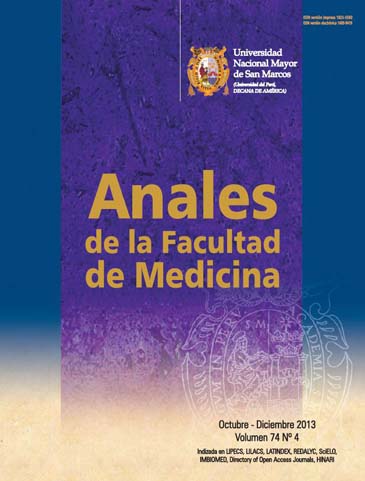Poverty and nutritional status-related intestinal parasitism in students, Huanuco, Peru, 2010
DOI:
https://doi.org/10.15381/anales.v74i4.2702Keywords:
Parasitic Intestinal diseases, nutritional status, students, poverty, Peru.Abstract
Introduction: Studies have reported high prevalence of parasitic disease in students from the jungle although none has associated itwith poverty and nutritional factors. Objectives: To determine the relationship between poverty and nutritional factors with the presenceof intestinal parasites in students from a Huanuco village. Design: Cross-sectional study. Setting: Venenillo hamlet, Huanuco, Peru.Participants: Students from the only school in Venenillo. Interventions: Parasitological examination by Lugol’s iodine direct examinationand Lumbreras' fast sedimentation technique was performed in 42 students. Level of poverty was determined by the unsatisfied basicneeds index and degree of malnutrition by the Waterlow index. Statistical analysis was performed using Goodman and Kruskal’sgamma coefficient. Main outcome measures: Intestinal parasitosis association with poverty and nutritional status. Results: Presence ofintestinal parasites was 97.6%. A strong association was found between parasitism and level of poverty (p=0.02, gamma=0.82). Therewas no significant association between level of malnutrition and parasitism. Conclusions: Association between intestinal parasitosis andpoverty was encountered in the studied population.Downloads
Published
2013-12-30
Issue
Section
Trabajos originales
License
Copyright (c) 2013 César Gabriel Berto Moreano, Judith Cahuana Aparco, Jesús Kevin Cárdenas Gallegos, Nataly Ruth Botiquín Ortiz, Claudia Angélica Balbín Navarro, Paul Jesús Tejada Llacsa, Esteffany Jennifer Calongos Porras

This work is licensed under a Creative Commons Attribution-NonCommercial-ShareAlike 4.0 International License.
Those authors who have publications with this magazine accept the following terms:
- Authors will retain their copyrights and guarantee the journal the right of first publication of their work, which will be simultaneously subject to Creative Commons Attribution License that allows third parties to share the work as long as its author and its first publication this magazine are indicated.
- Authors may adopt other non-exclusive licensing agreements for the distribution of the version of the published work (eg, deposit it in an institutional electronic file or publish it in a monographic volume) provided that the initial publication in this magazine is indicated.
- Authors are allowed and recommended to disseminate their work over the Internet (eg: in institutional telematic archives or on their website) before and during the submission process, which It can produce interesting exchanges and increase quotes from the published work. (See El efecto del acceso abierto ).
How to Cite
1.
Berto Moreano CG, Cahuana Aparco J, Cárdenas Gallegos JK, Botiquín Ortiz NR, Balbín Navarro CA, Tejada Llacsa PJ, et al. Poverty and nutritional status-related intestinal parasitism in students, Huanuco, Peru, 2010. An Fac med [Internet]. 2013 Dec. 30 [cited 2025 May 25];74(4):301-5. Available from: https://revistasinvestigacion.unmsm.edu.pe/index.php/anales/article/view/2702



